Property in Spain: What you need to know about buying a place with a terrace
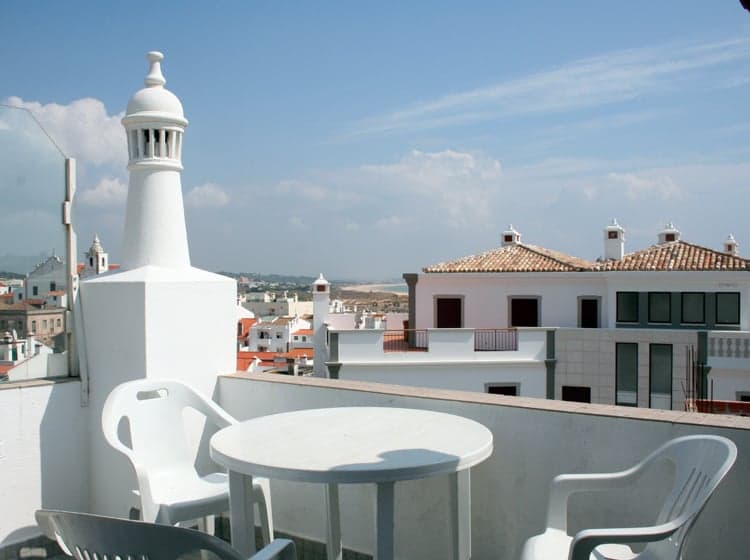
Anyone who has been confined inside for weeks on end during Spain’s coronavirus lockdown will be well aware of the advantages of a terrace.
If you have one then no doubt you have spent large parts of each day taking in fresh air, looking out on the world around you and once the days got warmer, tilting your face towards the sun for a much needed boost of vitamin D.
Those who aren’t lucky enough to have one will have been enviously shooting looks over at those who have, or dreaming about their next property and putting a terraza at the top of their must-have list.
Estate Agents, who may not have been able to show potential clients physically around properties but have still been fielding queries on line, report a surge in interest in those with outside spaces.
Graham Hunt from Valencia Property gives us the lowdown on what to look for and what you need to know when it comes to terraces.
“During the lockdown we have had a lot of online skype/zoom meetings with clients and all are keen to get here as soon as possible to start their search for a property. Currently it looks as if that will only be possible from midsummer onwards so for now anyone who is here already has a headstart,” he explains.
So with outdoor space being so sought after it’s important to remember that when it comes to terraces, all are not equal in terms of what you can do on them and who is responsible for the upkeep.
Different Types of Terraces
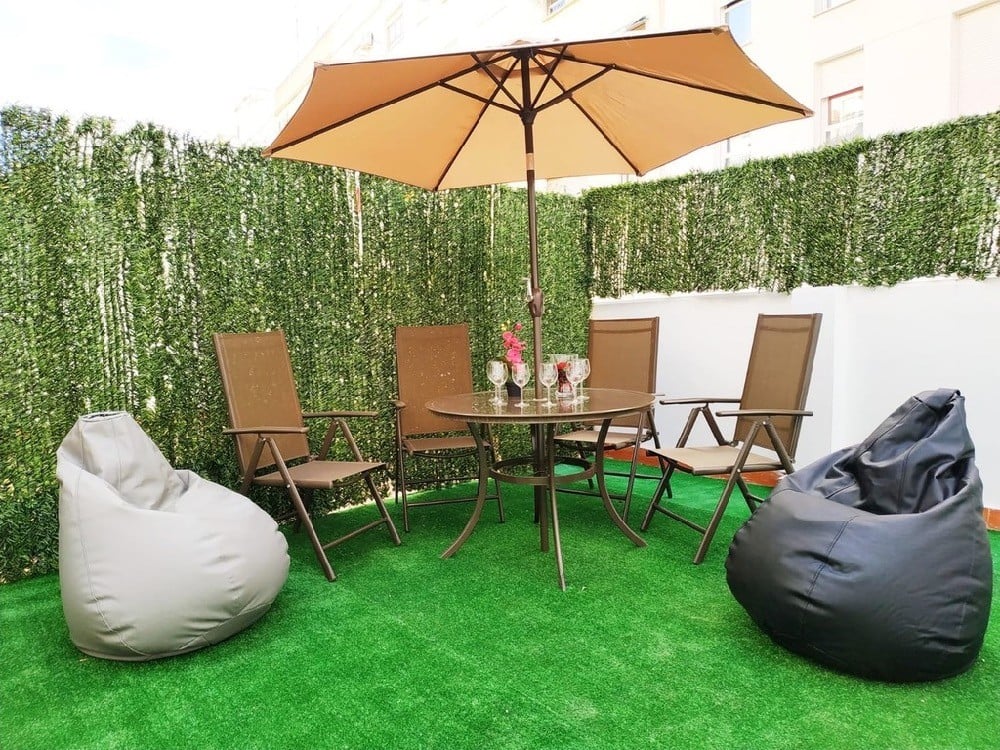
There are many types of terraces you can find in city apartments. Firstly, we have to distinguish the type of terrace. There are many. There are the first floor, mostly interior, terraces to the rear of the buildings, there are interior terraces in the middle of a building which are mostly lightwells but a bit bigger, there are terraces overlooking the street in intermediate floors and there are penthouses with their own terrace or with exclusive access to a terrace and finally there are common roof terraces.
Let’s have a look at each one in turn.
Common Terraces
Common terraces are usually on the flat roof of a building. They are found in many buildings dating from the 1950s and 1960s for example. They were often used for washing lines, storerooms and aerials and you can often find the machine rooms for lifts. I remember my first visit to Valencia in 1988 sunbathing on a roof terrace in Ruzafa and being gobsmacked by the number of individual TV aerials and wires holding them up. After sunbathing for too long you would come down looking like a zebra!
We always say to clients that if there is a common terrace and you have access to it then it is more than likely that you would have been the only one to ever use it if you decided to go up there except maybe for a little old lady who hangs her “not too smalls” out there every day. If the building doesn’t have a lift then you will see even fewer people up there. Many years ago a seller described in details his nude sunbathing on a roof overlooking the beach in Cabanyal… too much information, but his point was that nobody ever went up there (I think he may have mistaken cause and effect)
What Can You Do On A Common Terrace?
Officially you cannot do anything apart from be there. However that has not stopped people from setting up gazebos (Careful of the wind), barbecues and sets of tables and chairs up there especially when they can be stored in the “Trasteros” if they have one. We have even seen one client with a whole gym of loose weights on a rooftop, they got rusty.
Lightwell Terraces
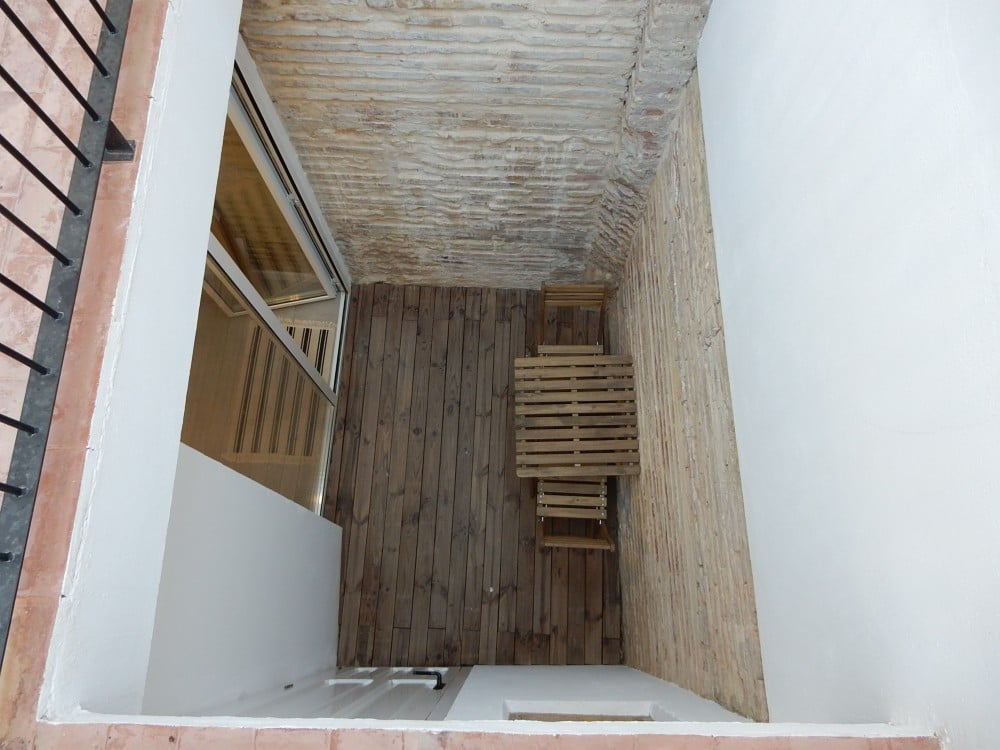
Photo: https://valencia-property.com/
It’s unusual to have a lightwell terrace that you would want to use. Many first floor flats advertise them as an added value but really there are rarely useful as the drains go down the middle of the building, despite their name there is usually little light, they don’t have much space and there is no breeze at all. Rarely you can find a decent one with space, light and one which is attractive enough to want to spend time on but again you are restricted to what you can do as the lightwell terrace belongs to the building as a whole, and you have to give access to it if there are any issues with pipework, gas or electric installations or damage to the shops, garages, offices or storage facilities underneath.
The upkeep of these areas is responsibility of the building as a whole but, as the owner of the apartment with access is the only person who can get in, cleaning and small repairs generally fall onto that person, along with wet socks, knickers, T-shirts etc from the inevitable washing lines above, because washing lines cannot go out onto the street.
Rear Terraces
Rear terraces are very popular and are a different kettle of fish. They are described on the deeds as a part of the building structure but for individual use of a particular apartment usually.
Again the upkeep is the responsibility of the building and the insurance of the building covers any damages usually but this can be a problem if you as an owner do any work that causes that damage. Lots of people put barbecues, small workshops, maybe a study or storeroom on “their” terrace and usually there isn’t a problem but when the terrace belongs to the building you should ask for permission to do this work and you will not believe the problems that jealousy can cause from the other neighbours who may block your idea.
What you are allowed to do is any upkeep of the walls, floors etc… that you feel are needed to keep the area in decent shape and decorate as you see fit with lights, plants, trellis plants etc… as they are all considered temporary. In theory this includes structures like gazebos and sunshades too in order to make the terrace more usable.
What you cannot do is build on it. And if you do then you are responsible for any damage to the building even if the building insurance would otherwise cover it. To get round this a lot of people use wooden sheds, PVC and glass structures and other wild and wooly methods to extend their living space.
You are allowed to use your terrace as you see fit as long as you don’t disturb the living arrangements of others, you can cover it in artificial grass or deck it or even change the floor tiles as long as you don’t block the drains that take water from it and again, as long as you get permission.
For things not involving building just ask the head of the community or tell them what you are going to do and you will get an idea if “Amparo from door 7” is going to cause a stink about it because once she was told off because her kids kept dirtying the walls on the stairs with their bike tyres and now she is like a hawk stopping anyone from doing anything at any time.
And yes, you can put a jacuzzi on it as it is not considered a permanent structure, but don’t be surprised if you have an audience looking down at you if you do or if people use it for target practice for their cigarette butts from above.
Penthouse Terraces
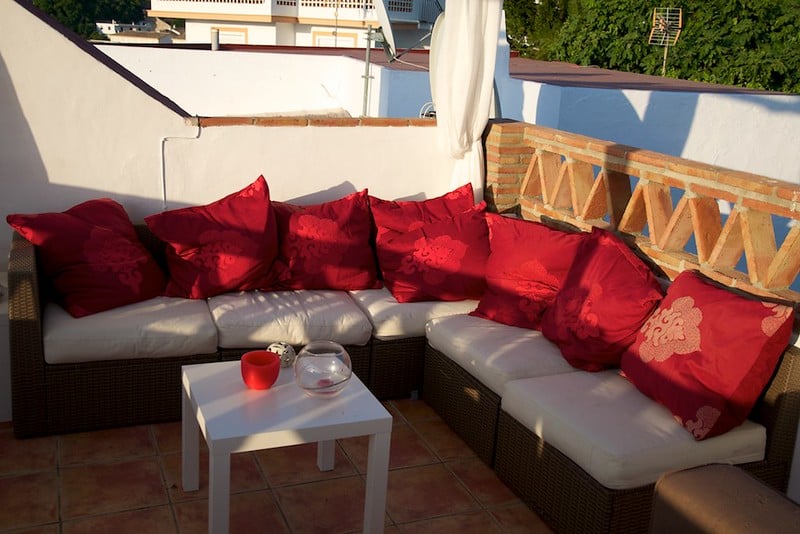
You feel you have the best deal and you may well have. You have your own terrace that will always get sun and occasionally get rain, you have your own awning that comes out from your wall and gives you some lovely shade and you are king of all you survey over the rooftops. Well, not quite…
The rules are more or less the same as for first floor terraces. Usually the terrace belongs to the building but you have individual access to it through your deeds (And your patio door). You are responsible for day to day upkeep but the building insurance deals with issues (Which always means “Goteras” (Leaks) in the apartment directly below you and it is always your fault because “You run around up there like an elephant” according to the person who lives below you.
Penthouse terraces are the best but they must be looked after because essentially they are the roof of the building and rain will find a way and when it rains in Valencia it pours! Make sure to never cover the drain exits (which may just be small holes under the balustrade) and this blocking can be done easily if you have more than a couple of plants and the leaves or flowers fall.
Can you “build” a wooden gazebo? Of course, but it mustn’t be considered a permanent structure. Can you extend your living room onto the terrace? Probably, and almost certainly, not. Have we seen extensions onto terraces? Oh yes!
Balconies and Mid Floor Terraces
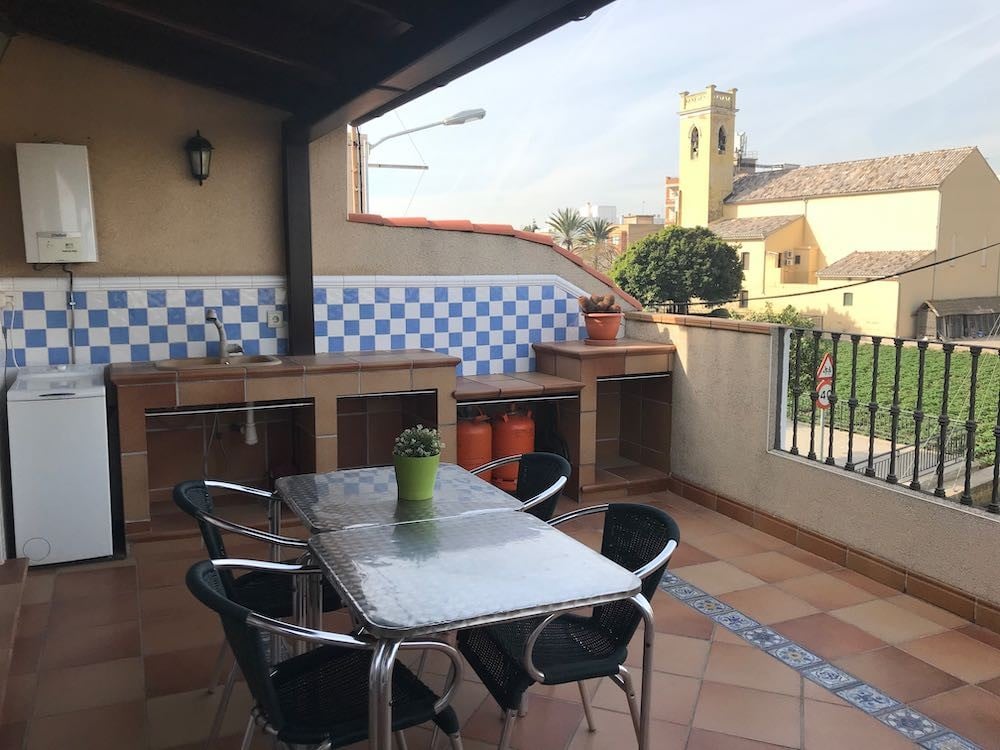
Town House with garden and terrace in Horno de Alcedo on the edge of Valencia. Two Houses in one Photo: https://valencia-property.com/
This type of terrace is generally smaller than it looked on the photos!
In other words estate agents will use a wide angle lens and give the impression that you could host a dinner party for 10 people on a balcony that may only take the weight and have the space to house two comfortably. What you can do here is limited by the space but you can usually copy everyone else and put out that table and two chairs from IKEA on the balcony, deck the floor with imitation wood and cram a pot plant into the corner. Generally you cannot enclose or glass them in and make an enclosed space, although why anyone would want to do this post Covid19 is beyond me. We often refer to them as smoking balconies for a simple reason, that’s about all you have the space to do on them and after a quick fag you will go back inside.
What’s the best terrace for you?
Well, there’s a Valencian secret about terraces which you would do well to heed. An eastern facing terrace is the best as you get the morning sun coming up and lighting up the interior of the house without the heat of the afternoon. Western facing terraces are great in spring and autumn for the sunsets without the heat of the summer but expect to need an awning or gazebo in high summer. South facing terraces are hot, hot, hot. Northern facing terraces are great for people wanting to avoid the sun as, especially on those on the first floor, the building will block out the sun almost always but those flats will be cold in the winter, not cool but cold as they don’t warm up during the day.
Choose your orientation with care.
Graham Hunt is a real estate agent and relocation expert based in Valencia. Originally from just outside Liverpool he came to Spain as a student and never left. Read more at his blog or follow him on Twitter.
And if you want him to show you around some properties in Valencia, drop him a line.
Comments
See Also
If you have one then no doubt you have spent large parts of each day taking in fresh air, looking out on the world around you and once the days got warmer, tilting your face towards the sun for a much needed boost of vitamin D.
Those who aren’t lucky enough to have one will have been enviously shooting looks over at those who have, or dreaming about their next property and putting a terraza at the top of their must-have list.
Estate Agents, who may not have been able to show potential clients physically around properties but have still been fielding queries on line, report a surge in interest in those with outside spaces.
Graham Hunt from Valencia Property gives us the lowdown on what to look for and what you need to know when it comes to terraces.
“During the lockdown we have had a lot of online skype/zoom meetings with clients and all are keen to get here as soon as possible to start their search for a property. Currently it looks as if that will only be possible from midsummer onwards so for now anyone who is here already has a headstart,” he explains.
So with outdoor space being so sought after it’s important to remember that when it comes to terraces, all are not equal in terms of what you can do on them and who is responsible for the upkeep.
Different Types of Terraces

There are many types of terraces you can find in city apartments. Firstly, we have to distinguish the type of terrace. There are many. There are the first floor, mostly interior, terraces to the rear of the buildings, there are interior terraces in the middle of a building which are mostly lightwells but a bit bigger, there are terraces overlooking the street in intermediate floors and there are penthouses with their own terrace or with exclusive access to a terrace and finally there are common roof terraces.
Let’s have a look at each one in turn.
Common Terraces
Common terraces are usually on the flat roof of a building. They are found in many buildings dating from the 1950s and 1960s for example. They were often used for washing lines, storerooms and aerials and you can often find the machine rooms for lifts. I remember my first visit to Valencia in 1988 sunbathing on a roof terrace in Ruzafa and being gobsmacked by the number of individual TV aerials and wires holding them up. After sunbathing for too long you would come down looking like a zebra!
We always say to clients that if there is a common terrace and you have access to it then it is more than likely that you would have been the only one to ever use it if you decided to go up there except maybe for a little old lady who hangs her “not too smalls” out there every day. If the building doesn’t have a lift then you will see even fewer people up there. Many years ago a seller described in details his nude sunbathing on a roof overlooking the beach in Cabanyal… too much information, but his point was that nobody ever went up there (I think he may have mistaken cause and effect)
What Can You Do On A Common Terrace?
Officially you cannot do anything apart from be there. However that has not stopped people from setting up gazebos (Careful of the wind), barbecues and sets of tables and chairs up there especially when they can be stored in the “Trasteros” if they have one. We have even seen one client with a whole gym of loose weights on a rooftop, they got rusty.
Lightwell Terraces

Photo: https://valencia-property.com/
It’s unusual to have a lightwell terrace that you would want to use. Many first floor flats advertise them as an added value but really there are rarely useful as the drains go down the middle of the building, despite their name there is usually little light, they don’t have much space and there is no breeze at all. Rarely you can find a decent one with space, light and one which is attractive enough to want to spend time on but again you are restricted to what you can do as the lightwell terrace belongs to the building as a whole, and you have to give access to it if there are any issues with pipework, gas or electric installations or damage to the shops, garages, offices or storage facilities underneath.
The upkeep of these areas is responsibility of the building as a whole but, as the owner of the apartment with access is the only person who can get in, cleaning and small repairs generally fall onto that person, along with wet socks, knickers, T-shirts etc from the inevitable washing lines above, because washing lines cannot go out onto the street.
Rear Terraces
Rear terraces are very popular and are a different kettle of fish. They are described on the deeds as a part of the building structure but for individual use of a particular apartment usually.
Again the upkeep is the responsibility of the building and the insurance of the building covers any damages usually but this can be a problem if you as an owner do any work that causes that damage. Lots of people put barbecues, small workshops, maybe a study or storeroom on “their” terrace and usually there isn’t a problem but when the terrace belongs to the building you should ask for permission to do this work and you will not believe the problems that jealousy can cause from the other neighbours who may block your idea.
What you are allowed to do is any upkeep of the walls, floors etc… that you feel are needed to keep the area in decent shape and decorate as you see fit with lights, plants, trellis plants etc… as they are all considered temporary. In theory this includes structures like gazebos and sunshades too in order to make the terrace more usable.
What you cannot do is build on it. And if you do then you are responsible for any damage to the building even if the building insurance would otherwise cover it. To get round this a lot of people use wooden sheds, PVC and glass structures and other wild and wooly methods to extend their living space.
You are allowed to use your terrace as you see fit as long as you don’t disturb the living arrangements of others, you can cover it in artificial grass or deck it or even change the floor tiles as long as you don’t block the drains that take water from it and again, as long as you get permission.
For things not involving building just ask the head of the community or tell them what you are going to do and you will get an idea if “Amparo from door 7” is going to cause a stink about it because once she was told off because her kids kept dirtying the walls on the stairs with their bike tyres and now she is like a hawk stopping anyone from doing anything at any time.
And yes, you can put a jacuzzi on it as it is not considered a permanent structure, but don’t be surprised if you have an audience looking down at you if you do or if people use it for target practice for their cigarette butts from above.
Penthouse Terraces

You feel you have the best deal and you may well have. You have your own terrace that will always get sun and occasionally get rain, you have your own awning that comes out from your wall and gives you some lovely shade and you are king of all you survey over the rooftops. Well, not quite…
The rules are more or less the same as for first floor terraces. Usually the terrace belongs to the building but you have individual access to it through your deeds (And your patio door). You are responsible for day to day upkeep but the building insurance deals with issues (Which always means “Goteras” (Leaks) in the apartment directly below you and it is always your fault because “You run around up there like an elephant” according to the person who lives below you.
Penthouse terraces are the best but they must be looked after because essentially they are the roof of the building and rain will find a way and when it rains in Valencia it pours! Make sure to never cover the drain exits (which may just be small holes under the balustrade) and this blocking can be done easily if you have more than a couple of plants and the leaves or flowers fall.
Can you “build” a wooden gazebo? Of course, but it mustn’t be considered a permanent structure. Can you extend your living room onto the terrace? Probably, and almost certainly, not. Have we seen extensions onto terraces? Oh yes!
Balconies and Mid Floor Terraces

Town House with garden and terrace in Horno de Alcedo on the edge of Valencia. Two Houses in one Photo: https://valencia-property.com/
This type of terrace is generally smaller than it looked on the photos!
In other words estate agents will use a wide angle lens and give the impression that you could host a dinner party for 10 people on a balcony that may only take the weight and have the space to house two comfortably. What you can do here is limited by the space but you can usually copy everyone else and put out that table and two chairs from IKEA on the balcony, deck the floor with imitation wood and cram a pot plant into the corner. Generally you cannot enclose or glass them in and make an enclosed space, although why anyone would want to do this post Covid19 is beyond me. We often refer to them as smoking balconies for a simple reason, that’s about all you have the space to do on them and after a quick fag you will go back inside.
What’s the best terrace for you?
Well, there’s a Valencian secret about terraces which you would do well to heed. An eastern facing terrace is the best as you get the morning sun coming up and lighting up the interior of the house without the heat of the afternoon. Western facing terraces are great in spring and autumn for the sunsets without the heat of the summer but expect to need an awning or gazebo in high summer. South facing terraces are hot, hot, hot. Northern facing terraces are great for people wanting to avoid the sun as, especially on those on the first floor, the building will block out the sun almost always but those flats will be cold in the winter, not cool but cold as they don’t warm up during the day.
Choose your orientation with care.
Graham Hunt is a real estate agent and relocation expert based in Valencia. Originally from just outside Liverpool he came to Spain as a student and never left. Read more at his blog or follow him on Twitter.
And if you want him to show you around some properties in Valencia, drop him a line.
Join the conversation in our comments section below. Share your own views and experience and if you have a question or suggestion for our journalists then email us at [email protected].
Please keep comments civil, constructive and on topic – and make sure to read our terms of use before getting involved.
Please log in here to leave a comment.